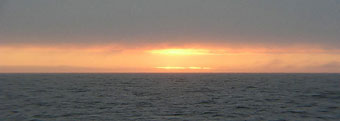

 | |||||||||
|
|
Journals 2006/2007Miriam Sutton
August 13, 2006 AM Location: Hopedale Trough (56° 56' 04.96" N, 56° 49' 44.45" W) I've just returned to work after basking in the evening sunset. The sun began peaking out from under the fog bank about one hour before sunset and I found myself relishing every minute it remained above the horizon. I have seen more fog in the past week than I usually see in a year... or two. Most of the crew seem unaffected by the lack of sunlight and their indifference has led me to a cultural discovery. Most of the crew are Canadians and they have lived in the northeastern region of Canada most of their lives. Going to sea in the fog is what they know. Fog is a weather phenomenon they are accustomed to and have adapted to quite well. When I chat with them about the rainy, foggy weather, they think it is fine, nice weather. I find this attitude quite foreign which, I guess, is quite normal because I am in a foreign country. And, if you're comparing a calm foggy day at sea to 20-foot seas and breaking waves, then the fog isn't so bad. (See Foggy Sunset photo below.)
So, where does all the fog come from? Fog is created between differences in air temperatures at the Earth's surface. As warmer air masses move out over the cool Labrador Sea water, the molecules are cooled and condensation occurs. These condensed particles often become trapped beneath a temperature inversion found above the Earth's surface. The trapped particles form fog. Fog particles are denser than water vapor particles and this increased density results in reduced visibility. Today's activity: Check the thermostat reading inside your house and record the temperature on a sheet of paper. Next, open your refrigerator freezer and observe the "fog" that develops immediately as you open the freezer door. Use a refrigerator/freezer thermometer to record the temperature of the freezer. Discuss with a friend why the "freezer fog" occurred. Word of the Day: Indifference REMINDER: Record today's Sea Surface Temperature (SST) and the Air Temperature on the data table you created from the August 05 journal entry. |
||||||||
